Picture yourself on the pristine shores of New Zealand, surrounded by turquoise waters that stretch as far as the eye can see. The air is alive with anticipation as you embark on a thrilling adventure like no other – whale watching in New Zealand, the land of the long white cloud & The Lord of The Rings!
Welcome to a world where the gentle giants of the deep roam freely, and you get a front-row seat to witness their awe-inspiring presence and this unique experience.
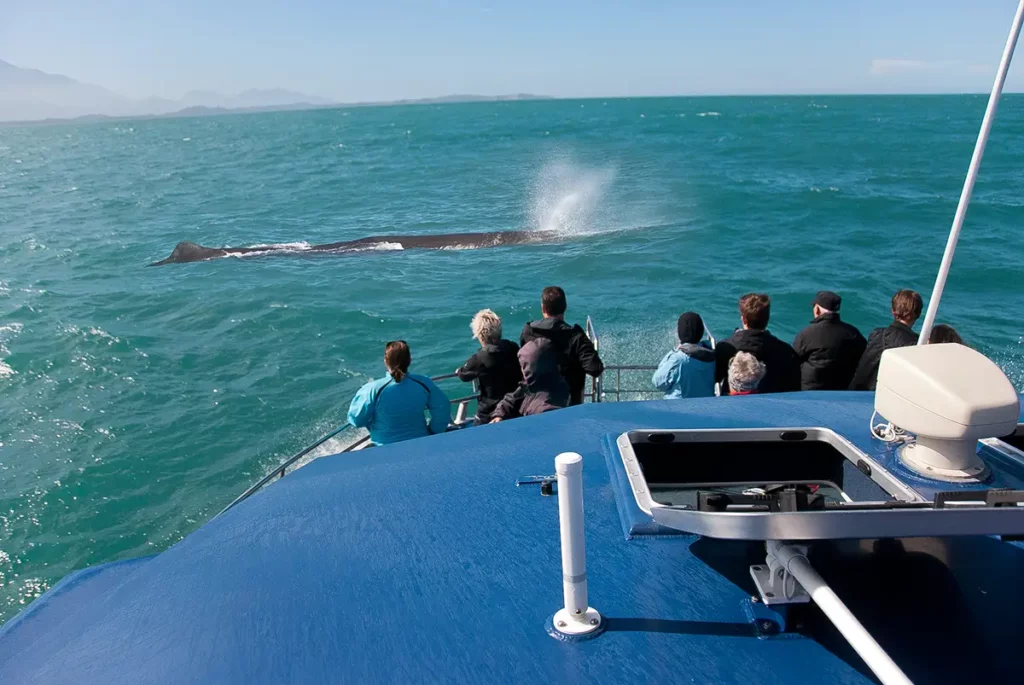
History of whaling in New Zealand and the rise of whale watching
Whales have played a significant role in New Zealand’s history, from the era of commercial whaling to the emergence of whale watching as a popular and sustainable tourism activity.
From the late 18th century to the early-mid 20th century, whalers hunted whales for their valuable resources, including oil, blubber, and baleen. Stations were established along the coast, attracting adventurous individuals seeking fortunes in the whaling trade. Whaling ships ventured into treacherous waters using harpoons and techniques to capture and process the whales.
The intensive hunting of whales during the whaling era had a devastating impact on whale populations worldwide, including those in New Zealand’s waters. Many species, such as the southern right whale and humpback whale, were pushed to the brink of extinction.
As the awareness of the ecological importance and beauty of whales grew, efforts were made to protect and conserve these magnificent creatures by implementing the Marine Mammal Protections Regulations in 1978 by the Department of Conservation (DOC).
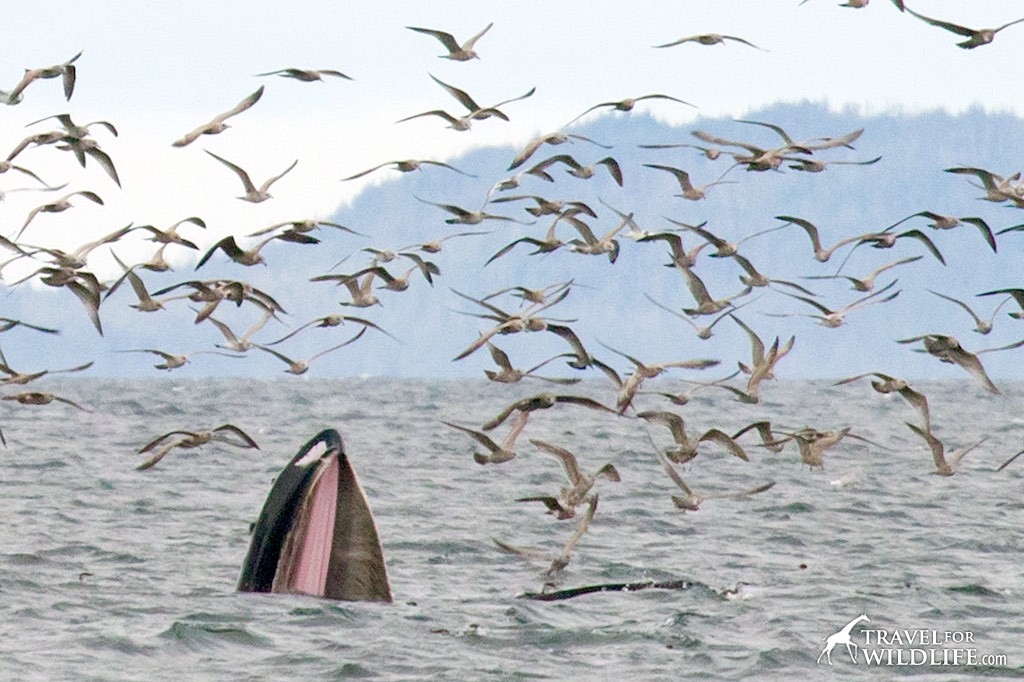
In the late 20th century, a significant shift occurred in the way humans interacted with whales. Instead of hunting them, people began to appreciate and observe them in their natural habitat. Whale watching emerged as an alternative to whaling, offering an opportunity to educate the public about marine conservation and raise awareness about the need to protect these incredible creatures.
What is the best whale watching destination in New Zealand?
New Zealand offers several world-class whale watching destinations, each with its own unique charm and opportunities to encounter these majestic creatures.
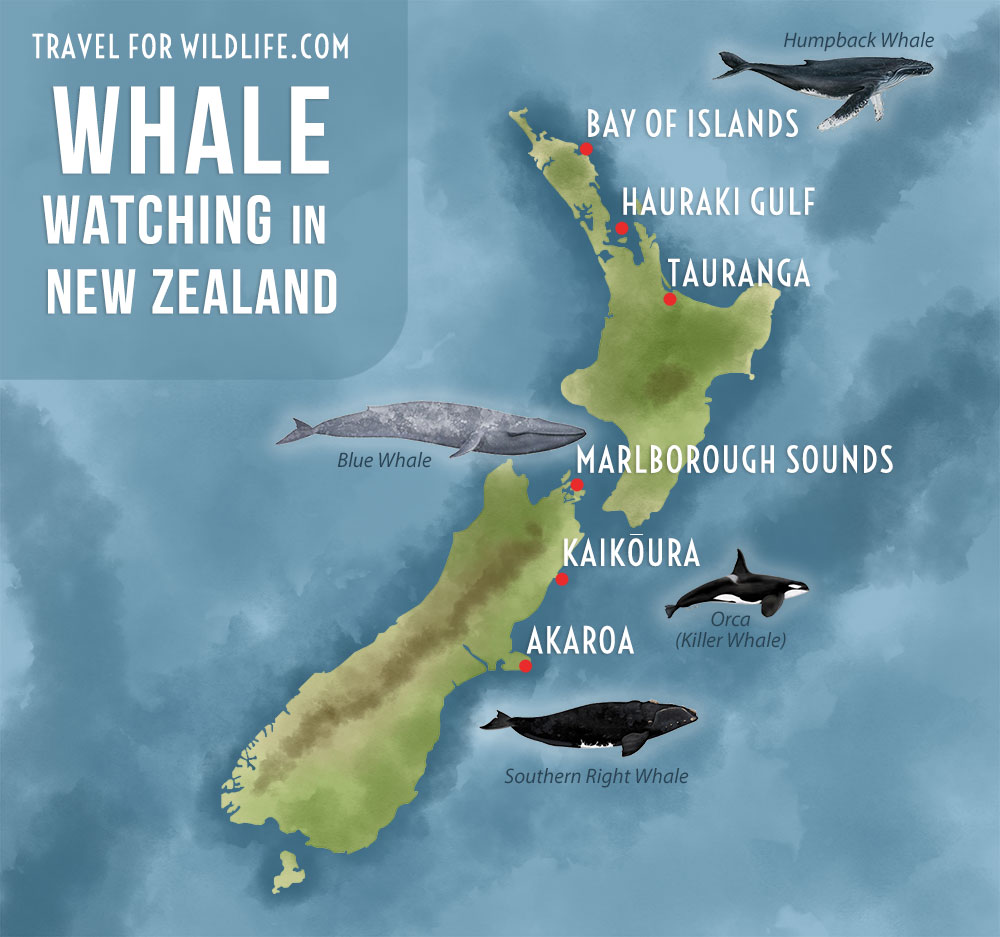
Kaikoura
Located on the east coast of the South Island, Kaikoura is a picturesque town nestled between the Pacific Ocean and the Kaikoura Ranges. It is also one of the best destinations in New Zealand to see whales. The town’s unique geography, with its deep underwater canyon, creates a perfect environment for rich marine biodiversity.
Kaikoura whale watching season: Humpback whales are seen June to August, orcas are present from October to April, and you can find sperm whales and dusky dolphins all year-round.
In addition to sperm whales, visitors to Kaikoura may also have the chance to see other whale species such as humpback whales, pilot whales, and even the occasional blue whale.
The town of Kaikoura is also home to a colony of New Zealand fur seals, which can often be seen lounging on the rocks near the shoreline. Dusky dolphins are another highlight in Kaikoura, known for their playful acrobatics and interactive behavior with boats and swimmers. Kaikoura offers a range of experiences, including whale watching boat tours, where knowledgeable guides provide insights into the whales’ behavior, the marine life in the deep Kaikoura canyon, and conservation efforts.
Scenic flights or a helicopter tour provide a breathtaking aerial perspective of marine wildlife and stunning coastal landscapes.
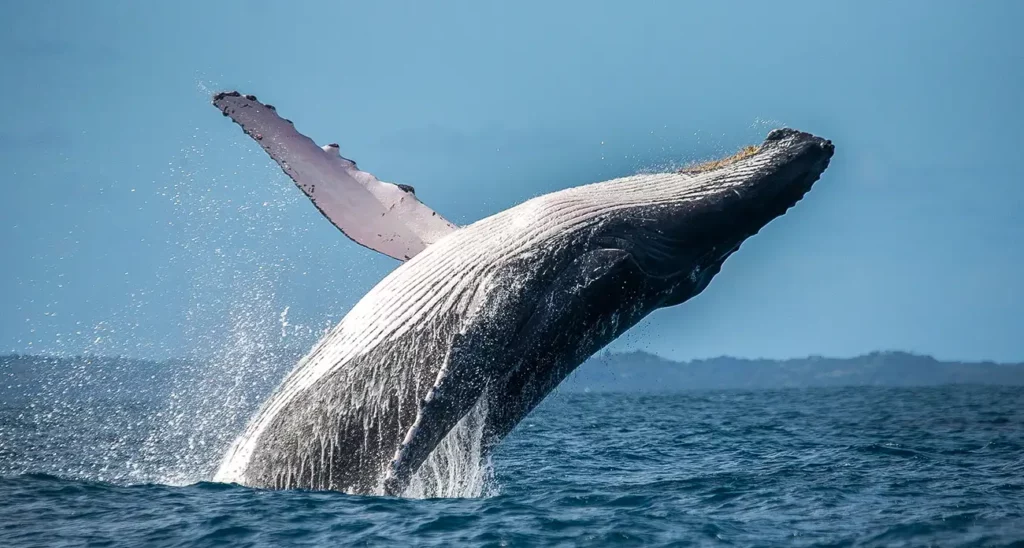
Bay of Islands
The Bay of Islands is a popular tourist destination known for its idyllic coastal scenery and historical significance. In addition to its beauty, the bay is home to a diverse array of marine
life.
Alongside bottlenose dolphins and common dolphins, visitors on a typical whale watch tour may encounter other species such as orcas, baleen whales like Bryde’s whales (Balaenoptera edeni), and occasionally even sei whales (Balaenoptera borealis).
One of the main attractions is the rare Hector’s dolphins (Cephalorhynchus hectori), which are often spotted in the area. These small, playful dolphins are endemic to New Zealand and are known for their distinctive black and white markings. Boat tours and kayak trips provide opportunities for up-close encounters with these delightful creatures, while also showcasing the bay’s stunning islands, secluded coves, and pristine beaches.
Marlborough Sounds
Situated at the top of the South Island, the Marlborough Sounds is a breathtaking region known for its intricate network of fjords, bays, and secluded inlets. The calm and sheltered waters provide an ideal environment for dolphins, seals, and other marine life.
Visitors to the Marlborough Sounds may have the opportunity to observe several dolphin species, including common dolphins and pods of Dusky dolphins, as they ride the bow waves of boats or gracefully swim alongside kayaks. Fur seals are a common sight, and if you’re lucky, you may even spot a pod of orcas patrolling the waters.
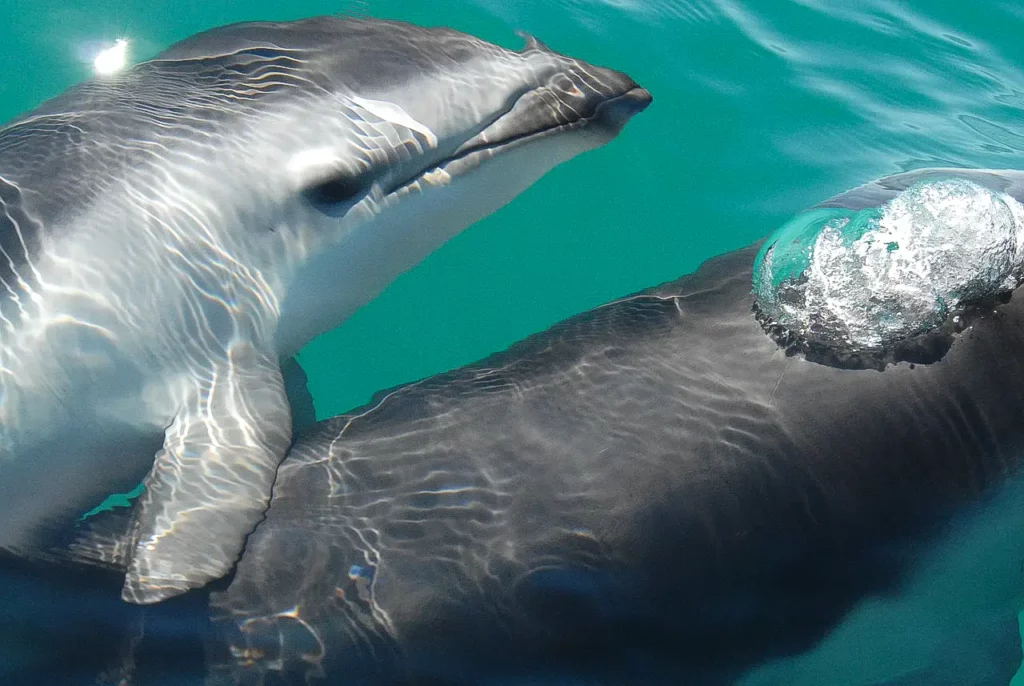
Boat tours and sea kayak rentals are available, offering a chance to explore the stunning waterways while enjoying close encounters with the local wildlife.
Hauraki Gulf
The Hauraki Gulf is a marine playground located off the coast of Auckland. This expansive coastal area is known for its diverse ecosystems, including numerous islands, sandy beaches, and abundant marine life. The gulf is home to a variety of dolphin species, including bottlenose dolphins, common dolphins, and the occasional orca pod.
Visitors can join boat tours departing from Auckland to venture into the gulf and witness these playful and intelligent creatures in their natural habitat. Along the way, you’ll be treated to scenic views of Auckland’s skyline, as well as the opportunity to spot other marine animals such as fur seals and seabirds.
Akaroa
Akaroa, a charming town on the Banks Peninsula near Christchurch, offers a unique opportunity to encounter the rare and endemic Hector’s dolphins. These small dolphins are known for their friendly nature and distinctive rounded dorsal fins.
Akaroa’s sheltered harbor provides a safe haven for these playful creatures, making it one of
the best places in the world to observe them up close.
Joining a dolphin cruise or a kayak tour around Akaroa Marine Reserve allows visitors to immerse themselves in the world of Hector’s dolphins and learn about their behavior, habitat, and conservation efforts. The scenic beauty of Akaroa, with its picturesque harbor, rolling hills, and French influence, adds
to the overall charm of the experience.
Tauranga
Tauranga, located in the Bay of Plenty region on the North Island, is known for its stunning coastline, beautiful beaches, and fantastic opportunities for whale and dolphin watching. Common dolphins and bottlenose dolphins are frequently spotted in the waters off Tauranga, where they showcase their acrobatic displays and playful behavior.
During the summer months, the area becomes a migration path for orcas, presenting an exciting chance to witness these powerful predators in action. Boat tours departing from Tauranga offer visitors the opportunity to witness these incredible marine creatures firsthand, while also enjoying the coastal beauty and panoramic views of the bay.
What species of whales and dolphins can you spot in New Zealand?
The mighty sperm whales (Physeter macrocephalus) reign supreme among New Zealand’s marine giants. They are the largest toothed whales and can grow up to a massive 20 meters in length! These magnificent creatures are known for their iconic square-shaped heads and impressive diving abilities, descending to depths of over 1,000 meters in search of their favorite prey, squid.
Prepare to be dazzled by the acrobatic displays of humpback whales (Megaptera novaeangliae). During their annual migration, they delight spectators by breaching out of the water and slapping their tails and pectoral fins against the surface. They are known for their hauntingly beautiful songs, which can travel great distances across the ocean.
Often referred to as the “wolves of the sea,” orcas (Orcinus orca) are apex predators known for their intelligence and complex social structures. In New Zealand’s coastal waters, you may witness pods of orcas showcasing their impressive hunting techniques, such as cooperative strategies to capture their prey. Orcas are highly vocal, using a variety of clicks, whistles, and calls to communicate with each other.
New Zealand is also home to several dolphin species, including the common dolphin (Delphinus delphis), and the dusky dolphin (Lagenorhynchus obscurus). These playful and intelligent marine mammals often accompany boats, riding the bow waves and performing energetic leaps and flips. Keep an eye out for their social behaviors, such as leaping in synchronized groups known as “porpoising,” and their ability to communicate using a wide range of clicks and whistles.
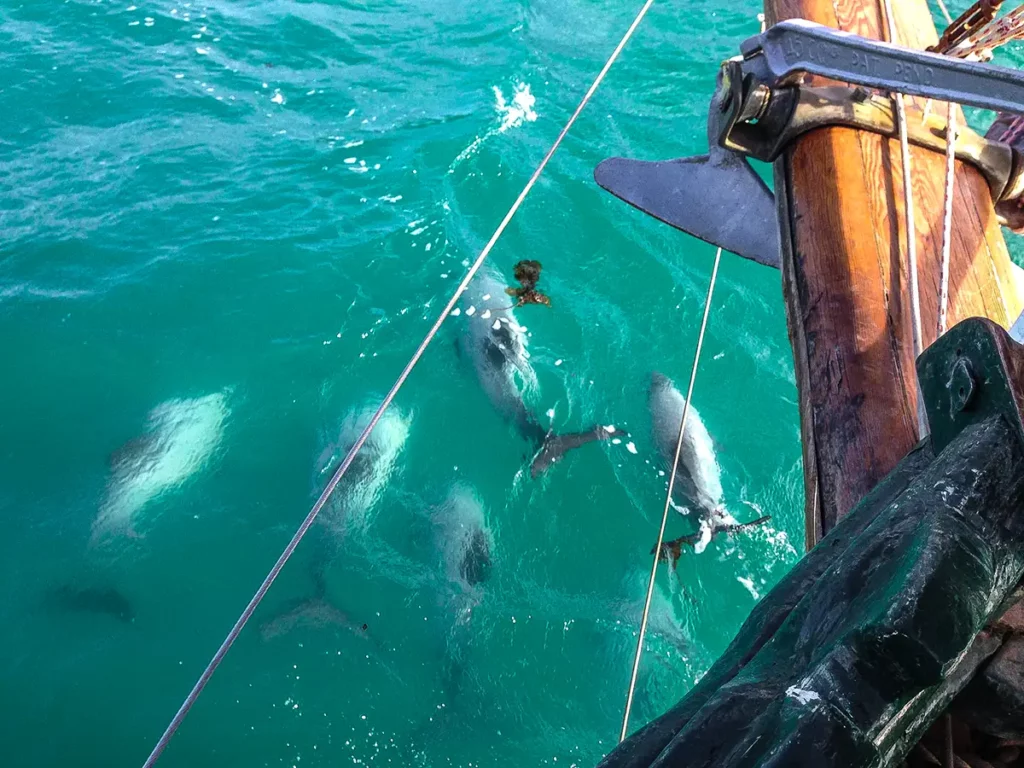
Alongside the whales and dolphins, seals also grace the shores of New Zealand. Two common seal species found in the region are the New Zealand fur seal (Arctocephalus forsteri), and the New Zealand sea lion (Phocarctos hookeri). These pinnipeds can be spotted sunbathing on rocks or swimming gracefully in the water. Seals are well-adapted to life both on land and in the sea, with streamlined bodies and flippers that allow them to swim and hunt with agility.
Whale migration in the waters of New Zealand explained
Humpback whale migration in New Zealand
Humpback whale migration in New Zealand is a remarkable natural event that occurs between May and November. During this time, humpback whales travel (approximately 10,000 km/yr) from their feeding grounds in Antarctica to the warmer waters of the South Pacific, Australia, and South Africa for breeding and calving purposes.
The migration routes typically follow the eastern coastlines of the North and South Islands, passing through areas like the Hauraki Gulf, Bay of Plenty, Cook Strait, and the Kaikoura region.
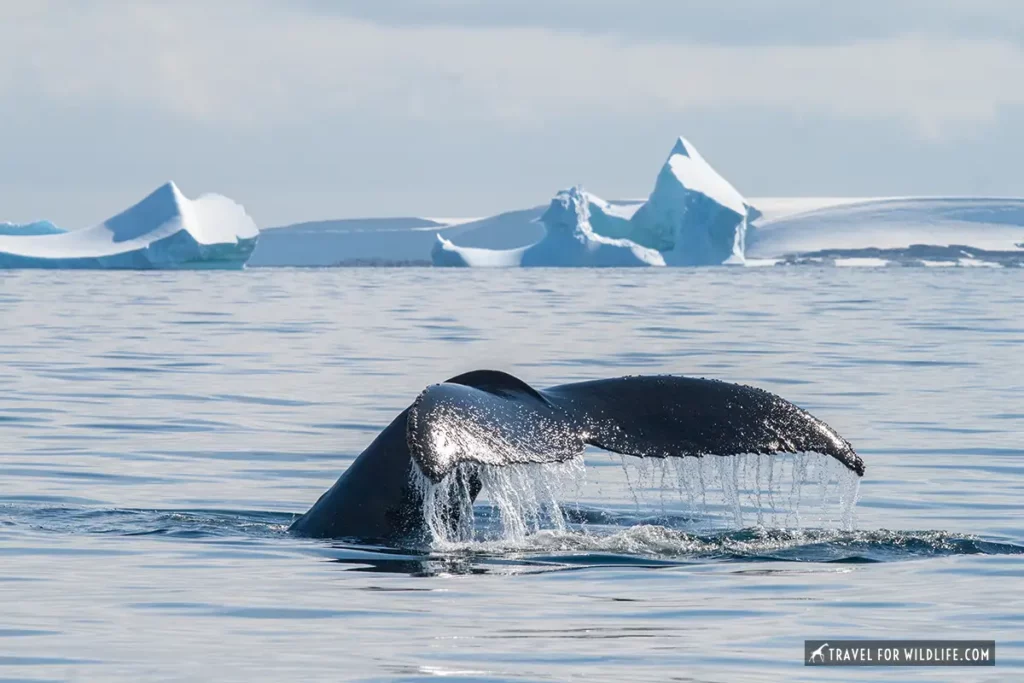
The DOC conducts annual surveys of these migratory visitors in Cook Strait to assess the status and recovery of humpback whales in New Zealand waters. These surveys provide valuable information on
migration patterns, destinations, and overall management of these whales.
It is the only project of its kind in New Zealand. Since 2008, OMV NZ Ltd has partnered with DOC to support this project, along with contributions from Transact Management Ltd, Bell Tea NZ Ltd, and the University of Auckland’s Molecular Ecology Laboratory.
Additionally, DOC participates in humpback research and management programs in the South Pacific. They collect photographs of whales encountered during the Cook Strait survey and by the public, creating a New Zealand catalog.
These photographs are compared with similar catalogs from other South Pacific countries through the South Pacific Whale Research Consortium. These catalogs help identify individual whales, estimate population sizes and movements, and genetic sampling is conducted to understand the relationship between New Zealand’s humpback whales and other populations.
Similar to humpback whales, blue whales, southern right whales, and orcas (also known as killer whales) can also be found in New Zealand’s waters during their respective migration seasons.
Blues whales, southern right whales, and orcas
Blue whales, the largest animal on Earth, undertake migrations from Antarctica to New Zealand’s waters during the summer months (around December to April) to feed on the abundant krill populations. They can be spotted in various regions, such as the Hauraki Gulf, Cook Strait, and the waters around the Chatham Islands.
Southern right whales migrate to New Zealand’s coastal waters primarily for breeding and calving. Their migration period occurs from May to October, overlapping with the humpback whales. Key areas for observing southern right whales include the Otago Peninsula, Foveaux Strait, and the Auckland Islands.
Orcas, the highly intelligent and social marine mammals also known as killer whale, are known to visit New Zealand throughout the year. They have transient and resident populations, with some individuals
migrating along the coasts in search of food, while others are more localized. Kaikoura is one of the best places to spot orcas, as they frequently travel along its coastline.
Whale migration is not only mesmerizing but also crucial for the life cycles of these whale and dolphin species. It ensures access to food, mating opportunities, and safer environments for raising their young. New Zealand’s geographic location makes it a vital stopover in the migratory routes of many whale species.
The conservation and education benefits of whale watching in New
Zealand
As we immerse ourselves in the wonder of whale watching, it’s crucial to remember our responsibility to protect these incredible creatures and their habitat. Whale populations have faced significant challenges due to human activities, making responsible whale watching practices essential for their conservation.
New Zealand takes pride in its strict regulations and guidelines governing whale watching activities. These regulations ensure that the encounters are conducted in a manner that minimizes disturbance to the whales and their environment.
By choosing reputable tour operators who prioritize responsible practices, we can contribute to the preservation of these majestic creatures for future generations.
The DOC plays a crucial role in the conservation and protection of marine mammals. They administer the Marine Mammals Protection Act 1978, which focuses on the conservation, protection, and management of these fascinating creatures.
To safeguard specific marine mammal species and their habitats, the Act allows for the establishment of marine mammal sanctuaries or marine reserves. New Zealand currently has seven marine mammal sanctuaries in place:
- Five sanctuaries protect the endangered Hector’s dolphin: West Coast North Island, Clifford and Cloudy Bay, Banks Peninsula, Catlins Coast, and Te Waewae Bay.
- One sanctuary at the Auckland Islands protects the main breeding areas of the New Zealand sea lion and the southern right whale.
- Another sanctuary in the Bay of Islands safeguards all marine mammals from high vessel interaction and provides safe zones for natural behaviors.
Education and awareness also play a vital role in marine conservation efforts. Many whale watching tours in New Zealand include educational components, where passionate guides share insights into the whales’ behaviors, migration patterns, and the importance of their conservation.
By fostering a deeper understanding and appreciation for these magnificent creatures, we can inspire a collective commitment to their protection.
New Zealand is recognized as one of the leading advocates for whale conservation on the international stage. As a founding member of the International Whaling Commission (IWC), New Zealand actively participates in advocating for whale conservation measures. DOC provides advice and representation at international conventions related to marine mammals, including the IWC and the Convention for the Conservation of Antarctic Marine Living Resources (CCAMLR).
Final Words
Whale watching in New Zealand is an extraordinary journey that connects us with the beauty and importance of the oceanic world. It allows us to witness the grandeur of these magnificent creatures while promoting their conservation.
Let us cherish these encounters and continue to protect and respect the gentle giants of the deep, ensuring their presence for generations to come.
About the author
Niels Thomas is a whale watching expert. He studied Wildlife Management in The Netherlands and is passionate about ethical and sustainable whale watching. Niels is the founder of Whale Watching Kaikoura, a guide to responsible whale watching in Kaikoura, New Zealand.
